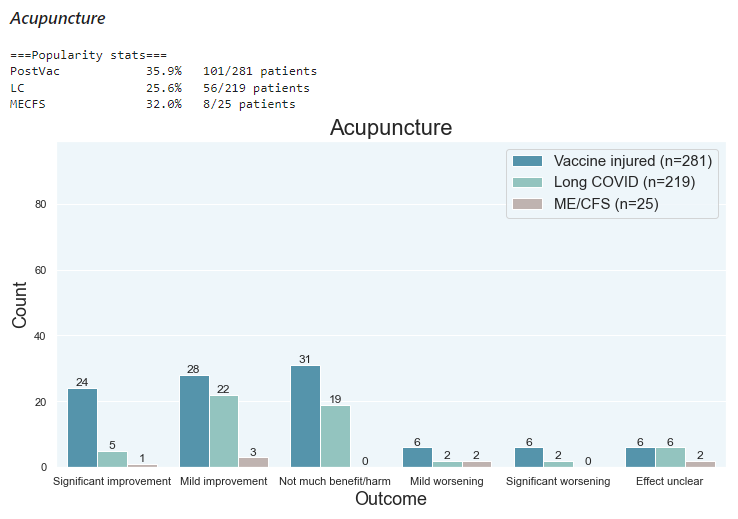235 treatments surveyed… here are some of the top treatments
The data dump for the Patient Experiences Survey is now available! Here are a few of the top treatments that have helped people recover:
- Cat’s claw - This plant extract has been used in traditional medicine. Only 20/459 (4.357%) tried this, which may explain why people aren’t talking about this.
- HBOT - See this primer for safety info on HBOT and other details.
- Fasting (usually for more than 48 hours) - Primer here.
- Nattokinase - Often used with serrapeptase, presumably as part of an anticoag approach.
Only about 8% of chronic illness patients are becoming mostly recovered. Potential reasons are:
- Most people aren’t trying the top treatments. HBOT is the most proven Long COVID treatment but patients and practitioners aren’t talking about it.
- Many treatments like HBOT seem to make some patients worse. It’s unclear if harm is reducing the likelihood of recovery. Unfortunately this is not a popular discussion topic. Starting with low doses and discontinuing early would likely reduce harm (and possibly aid in recovery).
- Response rates are very low. To find the signal, it takes large numbers AND iterations upon survey design. The iterations are needed because gathering reliable data is difficult.
→ Historically, patients have tried treatments without reliable data as to whether or not the treatments are a good idea. It should not be surprising that few patients are recovering.
The good news is that some people are recovering. It’s only a matter of time before we figure out how it happened. That is what my survey research tries to find out.
Implementing the treatments
You can easily order the supplements through iHerb (see this shopping list to make life easier for you), Amazon, other supplement retailers, etc.
How to use the data dump + what it’s for
Go to longhaulwiki.com/pes/
Do a Crtl+F search for the treatment in question. Keep going until you find the various risk score tables or the chart shown below.
The risk scores will give you a rough idea about how risky a treatment is. Acupuncture for example is surprisingly risky ![]() . People usually don’t report significant worsening for treatments.
. People usually don’t report significant worsening for treatments.
The second way to use it is to see how many people have tried it. If a lot of people have tried it and it’s on the survey, then it probably isn’t the magic cure that people are looking for. Anybody claiming 70% recovery or higher for a treatment is probably lying, dangerously incompetent, or intentionally deluding themselves.
See the first post in this thread for most detailed instructions on using the data dumps.
Other treatments
There are more treatments- but I will discuss the other ones in a future video because many of them are prescription drugs (e.g. colchicine, statins, ivermectin).
Surveys collect some unreliable data
Some of the treatments discussed here may turn out to be worthless. In an ideal world, we would have money to run controlled trials on the most promising treatments. Don’t take the survey data as gospel when it comes to what works.

